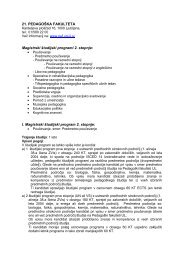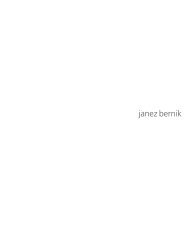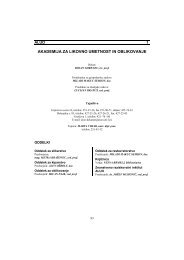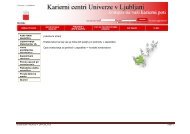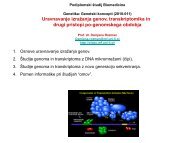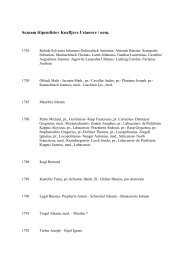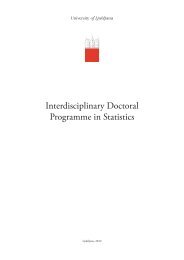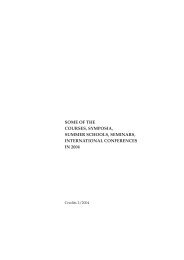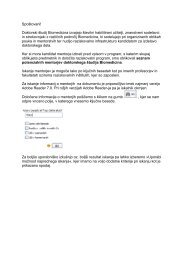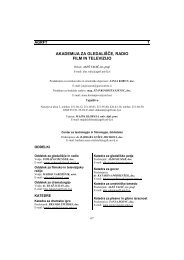Medicinska fakulteta Univerze v Ljubljani 1919–1945 - Univerza v ...
Medicinska fakulteta Univerze v Ljubljani 1919–1945 - Univerza v ...
Medicinska fakulteta Univerze v Ljubljani 1919–1945 - Univerza v ...
Create successful ePaper yourself
Turn your PDF publications into a flip-book with our unique Google optimized e-Paper software.
compulsory practicals conducted to the fullest extent� Within<br />
four semesters, the students mastered the modules required to sit<br />
the first medical final examination, which covered the subjects:<br />
general biology, experimental physics, inorganic chemistry and<br />
organic chemistry, anatomy, histology and physiology� Exams<br />
in physics and chemistry were theoretical only, whereas other<br />
subjects involved both theoretical and practical assessment�<br />
The first final examination was conducted in two parts� Exams<br />
in biology and physics took place at the beginning of the third<br />
semester or after two valid semesters� To be valid, a semester had<br />
to involve 12 hours of lectures and practicals a week� Exams in<br />
chemistry, anatomy, physiology and histology were taken in the<br />
fifth semester, if the candidate had covered four valid semesters<br />
and completed all the practicals�<br />
Changed examination rules applied to students enrolled in the<br />
1928/29 academic year or later; the chemistry exam was moved<br />
to the first part of the final examination and could be taken<br />
along with the exams in physics and biology after completing<br />
the second semester� At the chemistry exam, the candidate had<br />
to produce a positive report on his chemistry practicals which<br />
was awarded for completing laboratory assignments and an oral<br />
midterm exam� Failing this, he also had to take the practical<br />
part of the examination� Candidates could sit exams in anatomy,<br />
histology and physiology in that order after passing the first<br />
part of the final examination and finishing the fourth or fifth<br />
semester� To enter for the anatomy exam, candidates had to have<br />
two semesters of practicals in dissection� Physiology exam requirements<br />
included midterm exams in physiological chemistry and<br />
experimental physiology� A candidate who failed these midterms<br />
also had to take the practical part of the examination� In 1936, the<br />
Decree on Medical Faculties was issued, which in some respects<br />
introduced rather stricter regulations and was less advantageous<br />
for the students� It was opposed by all the medical students� The<br />
student protests were also supported by the professors� This<br />
lead to a general strike of the whole university and Rector Kušej<br />
closed the university� A revised decree of 1937 specified the main<br />
or compulsory and secondary or elective subjects which were<br />
categorised into five examination groups� In Ljubljana, students<br />
could still take only the exams in the first two examination<br />
groups� Exams in biology, physics and chemistry were taken after<br />
the second semester on four alternative dates, and the exams<br />
from the second groups, which covered anatomy, histology with<br />
embriology, physiology with physiological chemistry and sensory<br />
physiology were taken after the fourth semester and after passing<br />
group I exams� Group I and group II exams were required to enrol<br />
in the fifth and sixth semester, respectively�<br />
The first final examinations at the Ljubljana faculty were<br />
conducted in the 1921/22 academic year; a total of 23 were<br />
taken that year� In the following years, the number of exams taken<br />
127<br />
from the first two examination groups available at the Ljubljana<br />
Faculty of Medicine varied from a minimum of 13 in the 1928/29<br />
academic year to a maximum of 132 in the 1940/41 academic<br />
year� By this year, the prescribed examinations at the Ljubljana<br />
Faculty of Medicine were passed by 768 students who then had to<br />
continue their studies at foreign universities� Most of them went to<br />
Zagreb, some to Belgrade, and those more affluent went to Graz,<br />
Innsbruck, Vienna and other towns� For this reason, they always<br />
passionately strove for the completion of the Ljubljana Medical<br />
Faculty and, faced with constant threats of its abolishment, also<br />
took part in the struggle for its preservation� It was the medical<br />
students who played the crucial role in the development of a<br />
complete Faculty of Medicine in Ljubljana�<br />
1945 and the Establishment of a Complete<br />
Faculty of Medicine<br />
In 1945, liberation from the occupier’s supremacy and new<br />
social circumstances brought changes to life at the university�<br />
On 23 May 1945, a decree from the Education Ministry of the<br />
People’s Republic of Slovenia unconditionally restored work at<br />
the university� The old Yugoslav legislation remained temporarily<br />
in force, but the new government gradually started taking control<br />
of the university, which was already apparent in June when the<br />
Yugoslav National Liberation Anti-Fascist Council legislated the<br />
exclusion of the state’s faculties of medicine and pharmacy from<br />
the universities and subjected them to the Federal Ministry of<br />
National Health� Based on this act, the National Government of<br />
Slovenia established a complete Faculty of Medicine in Ljubljana<br />
with the Ordinance on dissolving the Faculty Council of the<br />
Faculty for Medicine in Ljubljana and appointing new teaching<br />
staff� The authors of a contribution about the medical faculty in<br />
the miscellany on the university’s fiftieth anniversary characterized<br />
the way in which the faculty was established as an unusual<br />
measure even for those times, which was perhaps not the only but<br />
certainly the shortest and surest path to realizing the century-old<br />
demand for a Slovenian medical faculty. With this ordinance,<br />
twelve full professors (Dr Alija Košir, Dr Albin Seliškar, Dr Franc<br />
Hribar, Dr Igor Tavčar, Dr Božidar Lavrič, Dr Bogdan Derč, Dr<br />
Ivan Marinčič, Dr Jernej Demšar, Dr Pavel Lunaček, Dr Leopold<br />
Jerše, Dr Bogdan Brecelj, Dr Jože Rant), five associate professors<br />
(Dr Hubert Pehani, Dr Valentina Kobe, Dr Josip Hebein, Dr<br />
Sabina Praprotnik, Dr Milica Valentinčič) and three assistant<br />
professors (Eng� Dušan Štucin, Dr Andrej Zupančič, Dr Ivan<br />
Pintar) were appointed to the faculty� With the ordinance, the<br />
Faculty of Medicine took an independent path for a few years,<br />
though it would have preferred to stay with the constellation of<br />
the university�



